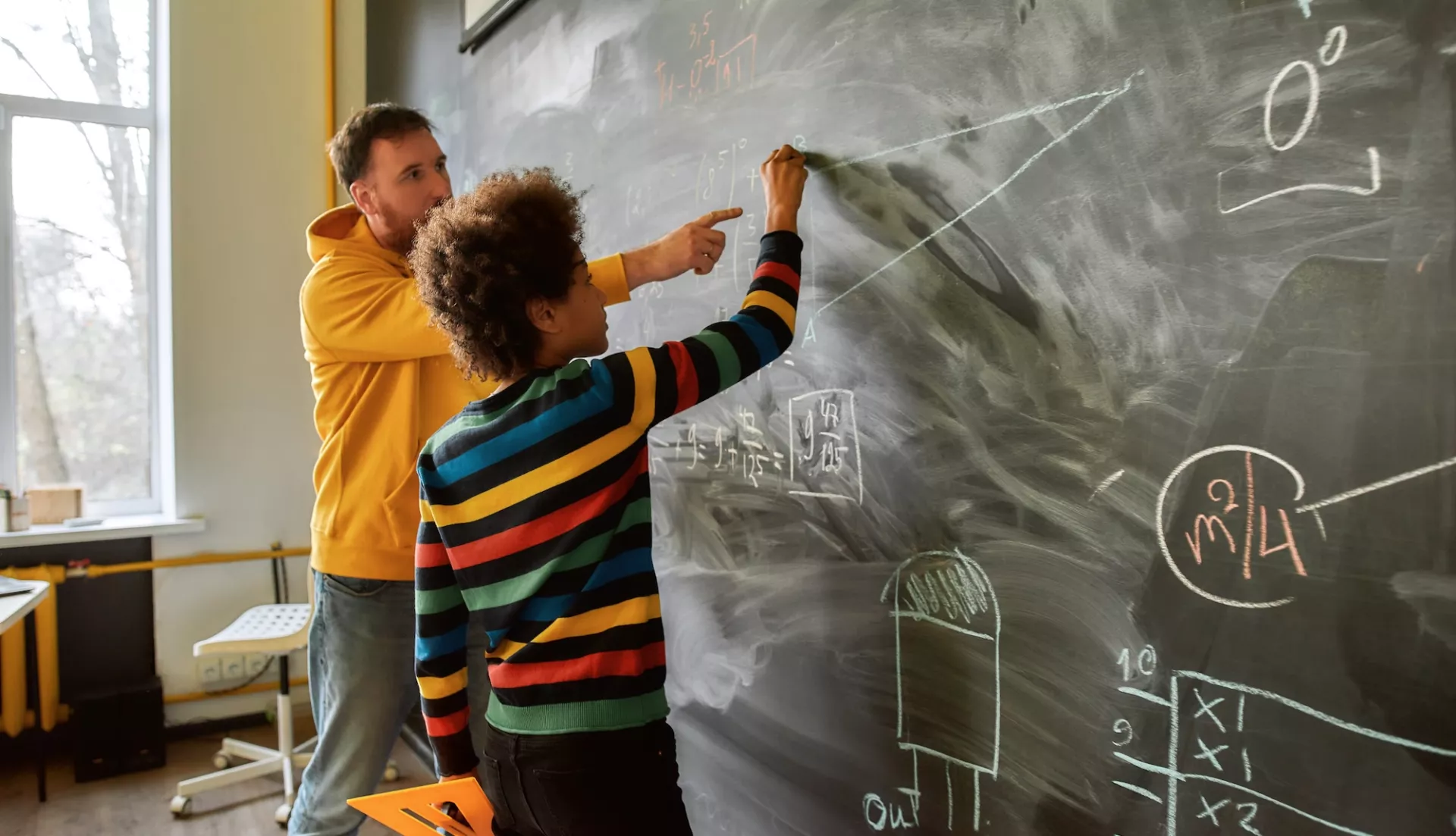Key Takeaways
- If designed and implemented properly, high-impact tutoring can be a tremendously effective tool for student learning recovery.
- In high-impact tutoring programs, small groups—no more than three to four students—meet at least three times a week with a professionally-trained tutor, during school hours. In addition to the high-quality materials used in the sessions, students benefit from meeting with the same tutor every week.
- The National Education Association and the National Student Support Accelerator have teamed up to help educators advocate for high-impact tutoring programs in their district.
Over the past few years, finding a consensus around the most effective strategies and interventions to address post-COVID learning recovery has largely been elusive. But there is widespread agreement that high-impact, or high-dosage, tutoring holds tremendous promise.
Where it has been properly implemented, high-impact tutoring produces large learning gains for a wide range of students, particularly those who have fallen behind academically.
That’s the conclusion of an increasing number of researchers, school leaders and classroom teachers who have seen the practice in action. High-impact tutoring has been shown to be 20 times more effective than standard tutoring models for math and 15 times more effective for reading. Studies demonstrate that the practice increases students’ learning by an additional three to 15 months across grade levels.
High-impact tutoring has not been enacted in many districts, but it should be. The U.S. Department of Education believes it is a model best practice and has urged states to use American Rescue Plan (ARP) funds to design and implement programs.
"The evidence is clear: high-impact tutoring works, and I've urged our nation's schools to provide every student who is struggling with extended access to an effective tutor," said Secretary of Education Miguel Cardona.
The National Education Association has been championing its potential—along with effective afterschool programs—since the height of the pandemic.
“Because so many students have faced exacerbated inequities through and beyond the COVID-19 pandemic,” said NEA President Becky Pringle, “We are called to use every tool in our toolbox that is proven to work in order to ensure that resources and supports are directed to the students who need them the most.”
High-impact tutoring, Pringle added, is a “rare opportunity.”
But it is one that brings challenges— especially funding. But the financial cost, along with the hard work behind design, planning and implementation would be well worth it for students, says Connie Michael, a teacher in Montana.
“If you can build that solid base of skills, especially in the earlier grades, in the beginning and focus on building relationships with students, the payoff could be huge.”
What is High-Impact Tutoring?

For the program to have a positive, sustained impact, researchers agree, schools have to adhere to certain specifications. The pillars of high-impact tutoring are:
-
Frequent (2 to 3 times a week) 30-minute sessions held during the school day
-
One-on-one or small group sessions with no more than 4 students
-
Professionally-trained tutors
-
A focus on relationship-building relationships by having students meet with the same tutors each session
-
High-quality materials that align with classroom content
In smaller groups that meet more frequently, educators can better tailor their instruction to the specific content gaps a student has missed or the skills they need to improve. And it is usually easier for a student to develop a relationship with a tutor they see at specific hours two or three times weekly.
That’s critical, says Maurice Telesford, a science teacher in Michigan.
“The tutor needs to be a consistent person, and not be some random person showing up every time,” he explains. “Students benefit if they have a chance to build a relationship with that individual. Even from a curriculum standpoint, the tutor knows the pedagogy and the way that curriculum is rolled out, so they can align their instruction and tutoring with what's happening in the classroom.”
A National Priority
In 2022-23 school year, some form of tutoring was available at more than 80% of U.S. schools, usually less intensive, “standard” tutoring. The Department of Education’s School Pulse Panel survey conducted in December 2022 found that only 37 percent of schools offer high-dosage tutoring and, nationwide, only 11 percent of public school students participate in these programs.
Given its track record so far in a small but growing number of districts, scaling and embedding high-dosage tutoring programs in more schools across the nation has a national priority. Expanding access, however, is a challenge.
The Biden Administration’s American Rescue Plan, passed in 2021, set aside nearly $170 billion for public schools—the single largest-ever investment in education funding. Over the past few years, NEA’s state and local affiliates have played a key role in making sure these resources were put to effective use. Identifying, designing, and implementing evidence-based policies and practices that can transform learning opportunities have been front and center. By mid-2023, $4 billion of the fund has been spent on tutoring and other accelerated learning programs.
Quote byNEA President Becky Pringle

In January 2024, the Biden Administration announced that high-dosage tutoring was one of the pillars of its Improving Student Achievement Agenda, a new push to assist states in closing stubborn learning gaps, as federal school rescue fund begins to wind down.
Founded in the Fall of 2020 by a group of education experts, the National Student Support Accelerator has helped districts bring high dosage tutoring to their classrooms. Originally housed at the Annenberg Center at Brown University, now at Stanford University, the Accelerator provides tools and resources—specifically a framework—to assist school leaders in structuring programs to best suit their students and communities.
Educators at the Table
In 2021, the Accelerator and NEA formed a partnership to elevate the voice of educators in this important work, creating the Tutoring Advisory Group. Consisting of nine educators, all NEA members, the group is an acknowledgement that high-impact tutoring programs must be supportive of teachers, rather than present another burden.
“It is critical to note that high-impact tutoring supplements classroom teaching, but does not replace it,” explains NEA President Pringle.
“That buy-in is very important,” says advisory group member Estafania Rios, a high school English teacher in New Jersey. “There is still a shortage around the country, and this will take time and energy in most districts. So, our input in this advisory group is very important.” Maurice Telesford and Connie Michael also serve on the advisory group.
Putting educators “in the research” was the goal, explained Elic Senter, manager of Education Policy and Practice at NEA. “We wanted to make sure the voice and expertise of our members were heard in the design and execution of the resources the Accelerator was rolling out. Every resource was vetted by these educators.”
The partnership between the National Student Achievement Accelerator and NEA also produced the Educator Union Leaders’ Guide, a comprehensive blueprint to advocate for high-dosage tutoring programs in school districts.
The guide, Pringle says, provides “the tools and resources needed to lead the way in building student-centered, student-focused, educator-led efforts to ensure safe, just, inclusive and supportive learning environments for every student.”
Included in the guide are strategies on developing a rationale for high-dosage tutoring, building coalitions with various stakeholders, navigating around common obstacles, understanding any bargaining implications, and identifying potential new funding streams.
“When you have research-driven supports like high-impact tutoring, it is critical that our union members and leaders are advancing those strategies and supports,” said Senter. “They have to be at the table in the decision-making spaces in driving the implementation.”
Suggested Further Reading
-
Educator Union Leaders' Guide: High-Impact Tutoring Advocacy
National Student Support Accelerator
-
High-Impact Tutoring: Research Overview
National Student Support Accelerator
-
The State of School Tutoring in Charts
Education Week
-
Many Schools Want to Keep Tutoring Going When COVID Money is Gone. How Will They Pay for it?
ChalkBeat


